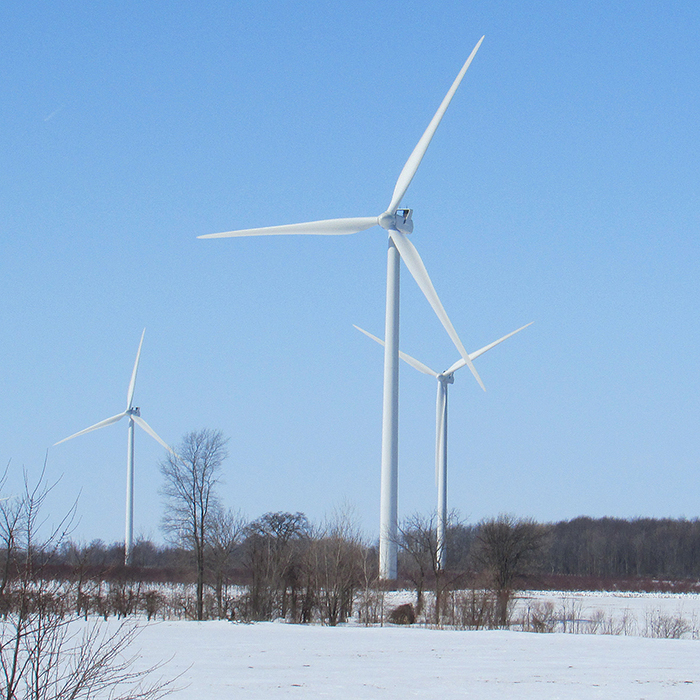
The Otter Creek Wind Farm Project submitted its application recently to the Ministry of the Environment and Climate Change (MOECC) for a Renewable Energy Approval (REA) and has committed to voluntary water well testing before construction begins.
The project calls for the construction of 12 “super” turbines (4.2 MW) north of Wallaceburg.
According to a release from Boralex, a partner in the project with RES Canada, as soon as the MOECC confirms the application is complete in approximately two or three months, there will be a posting on the Environmental Registry, and the public will be able to comment on the REA submission. The final REA reports will also be available on the project’s website shortly thereafter.
Boralex made the following statement in its release about the concerns regarding water wells:
Throughout the REA process, several stakeholder groups raised concerns about the construction and operation of wind turbines and their potential impacts on water wells.
Many of the comments received related to the concern that aquifer-based well water quality would become compromised as a result of vibrations created by pile driving (into the bedrock) during the installation of wind turbine foundations, and/or operation of these turbines with piles.
In response to these concerns, Otter Creek consulted with qualified professionals (licensed P.Eng. and P.Geo.) from both GHD and Golder Associates, two engineering consultant groups, about the potential for pile foundations to have a negative impact on water wells.
“GHD was hired by Otter Creek to review the report Golder Associates prepared as part of the North Kent Wind 1 Project (the Golder Report, September 2016) to determine whether the conclusions of the report were valid and could apply to the Project. The main conclusions from GHD’s review are:
- Based on the similarity of geologic conditions confirmed by GHD at the Otter Creek Site and those presented in the Golder Report, GHD believes that the Golder Report conclusions are applicable to the Otter Creek Site.
- The Report concludes, and GHD concurs, that given that the typical residential well pump operational vibration intensity threshold is in the range of 3 to 9 mm/s, it is highly unlikely (nearly impossible) that vibrations induced by pile driving can cause dislodgement of sediments that would not be otherwise dislodged by existing pump vibration.
- GHD is not aware of any report or study confirming a plausible mechanism for vibrations induced by wind turbine operations to cause sediment dislodgement at distances beyond the common turbine exclusion zones.
Based on these conclusions, Otter Creek does not anticipate that either the construction or operation of the facilities will have any negative impact on water wells.
A full copy of GHD’s review of Golder’s report is included in Otter Creek’s REA application submission and can also be found on the Otter Creek website.
While Otter Creek relies upon the conclusions of qualified experts, it is also committed to being a good neighbour and to helping alleviate the public’s concerns. As a result, Otter Creek is also voluntarily committing to testing active water wells within one kilometre of key project infrastructure – specifically wind turbines, the substation and the meteorological tower – prior to starting construction of the facility.
Tests will be conducted by independent qualified professionals in Ontario and the results of this testing will be given to each landowner that chooses to participate in the program. During the facility’s construction or within the first year of operation, should any complaints arise from parties that chose to participate in this preconstruction water well testing program, Otter Creek will hire an independent qualified professional to collect a water sample for analysis.
Should this analysis confirm there is a water quality issue that was not present in the preconstruction sample, Otter Creek will provide the party with potable water while the complaint is being investigated by a qualified professional (P.Eng. or P.Geo.) hired by Otter Creek to determine whether the change can be reasonably attributed to Otter Creek.
Complaints arising during the facility’s construction or within the first year of operation from parties within one kilometre of key project infrastructure that did not participate in preconstruction water well testing will be investigated. However, these parties will not be eligible to receive potable water from Otter Creek during the investigation period.
Another concern of the group Water Wells First is it claims that the Golder Report, being used by the North Kent Wind project group and Otter Creek, does not take into account the presence of Kettle Point black shale, which is known to contain heavy metals. A report commissioned by WWF, by Dr. Buckingham, (P. Eng, Phd) is available to the public, however, Asier Ania, Project Manager Development at Boralex said WWF has not made any of the reports or data available to them for review.
Otter Creek project at a glance
- Partnership among Renewable Energy Systems Canada (RES), Boralex Inc., as well as Walpole Island First Nation.
- Capacity up to 50 MW and 12 turbines
- An investment of $150 million
- Operational by late 2019
Information on the project can be found at www.ottercreekwindfarm.ca






